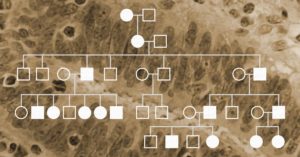Lynch Syndrome is the autosomal dominant hereditary predisposition to develop colorectal cancer and certain other cancers. This simple, one sentence definition seems woefully inadequate considering the human toll this condition has inflicted on the families that have it in their genetic pedigree.
They Called it a Curse
To one family, perhaps the family when it comes to this condition, Lynch Syndrome has meant heartache and hope; grief and joy; death and life. Their story is told by Ami McKay in her book Daughter of Family G, and it is at once both a memoir of a Lynch Syndrome previvor (someone with a Lynch Syndrome genomic mutation who has not yet developed cancer) and a poignant and honest account of the family that helped science put name to a curse.
“The doctors called it cancer. I say it’s a curse. I wish I knew what we did to deserve it.”
Anna Haab from Daughter of Family G (1)

The scientific community first met “Family G” as the meticulously created family tree, filled with the stunted branches that mark early deaths by cancer. The pedigree was first published in 1913 in Archives of Internal Medicine (2). In the article, Dr. Alderd Warthin wrote: “A marked susceptibility to carcinoma exists in the case of certain family generations and family groups.” In 1925, an expanded pedigree of circles and squares was published in Dr. Warthin’s follow up study in the Journal of Cancer Research (3). But each circle and square in that pedigree denotes a person. Each line represents their dreams together for the future, and Ms. McKay wants us to know their names: Johannes and Anna, Kathrina, Elmer, Tillie, Sarah Anne (Sally); and—most importantly—Pauline. Because without Pauline there would be no story.
Continue reading “Lessons in History, Hope and Living with Lynch Syndrome from the “Daughter of Family G””